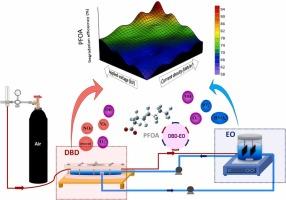Per-and polyfluoroalkyl degradation in a hybrid dielectric barrier discharge plasma and electrooxidation system through involving more reactive species by air and water circulation
IF 12.2
1区 环境科学与生态学
Q1 ENGINEERING, ENVIRONMENTAL
引用次数: 0
Abstract
The presence of PFAS in water matrices has become a global environmental issue in the last half-century. Dielectric barrier discharge (DBD) and electrooxidation (EO) showed potential for PFAS degradation but have yet to find practical application due to relatively high energy consumption. In this study, a hybrid DBD-EO system for efficient degradation of PFAS was developed by involving more reactive oxygen, sulfate radicals () and nitrogen species (RONS). The results showed that using the hybrid DBD-EO system under optimal conditions (applied voltage = 6 kV and current density = 7.5 mA/cm2) could increase PFOA degradation efficiency from 65.0% (DBD) and 62.5% (EO) to 89.14%. While the EE/O decreased from 67.0 kWh/m3 (DBD) and 47.82 kWh/m3 (EO) to 21.61 kWh/m3. In addition, the effect of operational parameters and water matrices revealed that the hybrid DBD-EO system had high potential for PFOA removal from water under various conditions. According to the EPR and DFT calculation results, integration of reactive species in EO (, •OH, ) and ONOOH) and DBD (•OH, , , 1O2 and ONOOH) processes in the DBD-EO system led to efficient degradation of PFOA through a mechanism of decarboxylation/defluorination cycle. Our findings suggested the combination of DBD and EO is a promising approach for complete degradation of PFAS from water with low energy consumption and minimal environmental side effects.

在混合介质阻挡放电等离子体和电氧化系统中,通过空气和水循环吸收更多的反应物质降解多氟烷基
在过去的半个世纪中,PFAS在水基质中的存在已成为一个全球性的环境问题。介质阻挡放电(DBD)和电氧化(EO)具有降解PFAS的潜力,但由于相对较高的能耗,尚未得到实际应用。在本研究中,通过引入更多的活性氧、硫酸盐自由基(SO4•−)和氮种(RONS),开发了一种高效降解PFAS的DBD-EO混合体系。结果表明,在最佳条件下(施加电压= 6 kV,电流密度= 7.5 mA/cm2), DBD-EO混合体系可将PFOA降解效率从65.0% (DBD)和62.5% (EO)提高到89.14%。而EE/O从67.0 kWh/m3 (DBD)和47.82 kWh/m3 (EO)下降到21.61 kWh/m3。此外,操作参数和水基质的影响表明,DBD-EO混合体系在各种条件下都具有较高的去除水中PFOA的潜力。EPR和DFT计算结果表明,DBD-EO体系中EO (SO4•−、•OH、O2•−)和DBD(•OH、O2•−、NO2•−、1O2和ONOOH)反应组分的整合通过脱羧/脱氟循环机制实现了PFOA的高效降解。我们的研究结果表明,DBD和EO的组合是一种很有前途的方法,可以完全降解水中的PFAS,能耗低,环境副作用小。
本文章由计算机程序翻译,如有差异,请以英文原文为准。
求助全文
约1分钟内获得全文
求助全文
来源期刊

Journal of Hazardous Materials
工程技术-工程:环境
CiteScore
25.40
自引率
5.90%
发文量
3059
审稿时长
58 days
期刊介绍:
The Journal of Hazardous Materials serves as a global platform for promoting cutting-edge research in the field of Environmental Science and Engineering. Our publication features a wide range of articles, including full-length research papers, review articles, and perspectives, with the aim of enhancing our understanding of the dangers and risks associated with various materials concerning public health and the environment. It is important to note that the term "environmental contaminants" refers specifically to substances that pose hazardous effects through contamination, while excluding those that do not have such impacts on the environment or human health. Moreover, we emphasize the distinction between wastes and hazardous materials in order to provide further clarity on the scope of the journal. We have a keen interest in exploring specific compounds and microbial agents that have adverse effects on the environment.
 求助内容:
求助内容: 应助结果提醒方式:
应助结果提醒方式:


